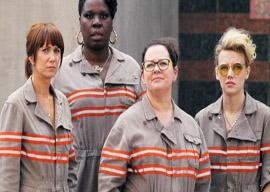
July 20, 2016

It might have been possible to adapt Venkman’s personality for an actress. Indeed, my hunch is that screenwriters Lee Eisenberg and Gene Stupnitsky, who wrote a draft of a Ghostbusters III sequel in 2009 that got lost in development hell, used Venkman as their model for Cameron Diaz’s sociopathic heroine in their 2011 hit Bad Teacher.
But Feig doesn”t try to come up with an intriguing personality for Wiig, instead assigning the Jennifer Aniston look-alike the bland audience surrogate role as the nice voice of reason.
In the Dan Aykroyd role, Melissa McCarthy is about as okay as Aykroyd was. There’s a widespread assumption that because McCarthy is both overweight and a star, she must be a superbly coordinated physical comedian in the tradition of Oliver Hardy, Jackie Gleason, Chris Farley, and Kevin James. But actually, she’s not.
Kate McKinnon is more entertaining than the late Harold Ramis was (a handsome but stiff actor, he was an impressive filmmaker, peaking in 1993 with Groundhog Day). And she even has a relatively novel role as a lesbian who happily smiles rather than angrily scowls. But her lines are not particularly funny and her mugging eventually gets exhausting.
It also doesn”t help that Feig decided to triple her technobabble for STEM girl-power reasons. Listening to McKinnon, I often felt like Henry Kissinger must have at Theranos board meetings while CEO Elizabeth Holmes spewed techno-jargon: I sure hope there’s not going to be a quiz.
Leslie Jones, the giant black lady from Saturday Night Live whose main shtick is her good-natured joking about being a black giantess (she’s almost a foot taller than comedian Kevin Hart), is comparable to Ernie Hudson in the role of the Vaguely Defined Black Worker. (Aykroyd had intended the role for Eddie Murphy, thus figuring there was no point in putting much planning into the character because Murphy would no doubt improvise something more brilliant than the writers could come up with. But then Murphy got Beverly Hills Cop instead of Sylvester Stallone and couldn”t make Ghostbusters.)
Feig chose not to exploit Jones” size for humor, which no doubt would have set off a Twitter storm over body shaming. But that decision inevitably turned out like a Kevin Hart movie in which nobody notices he’s short.
Beside Murray’s superlative performance and Parker’s song, the old Ghostbusters was powered by its Reagan-era pro-business attitude (recall that the EPA bureaucrat is the human bad guy). After all the antibusiness movies of the 1970s, this tech start-up allegory was galvanizing at the time.
Feig drops most of that aspect. But that leaves his movie undermotivated.
Why do the ladies want to launch a start-up, much less one in now enormously expensive Manhattan? The new movie nicely acknowledges the how-can-they-afford-that problem by noting that the firehouse used by the original Ghostbusters now rents for $21,000 per month. So they rent the second floor of a restaurant in Chinatown instead, although that sounds awfully pricey, too. The remake would better have been set in Brooklyn, although that would have raised a controversy over gentrification.
A better idea for the new movie would have been to keep the old timeline and assume we”re now 32 years past the 1984 invention of ghostbusting. It’s now become a municipal institution like the fire department. The men hired to bust ghosts in the 20th century are now paunchy timeservers awaiting their ruinously lavish pensions and hiring only their nephews to succeed them. The new liberal mayor has promised to diversify the ghostbusting department by making the hiring test easy enough for women to pass. But then the new girls discover that busting ghosts is scarier than they had assumed, kind of like fighting fires turned out to be on 9/11 when 343 firemen (but no firewomen) died.